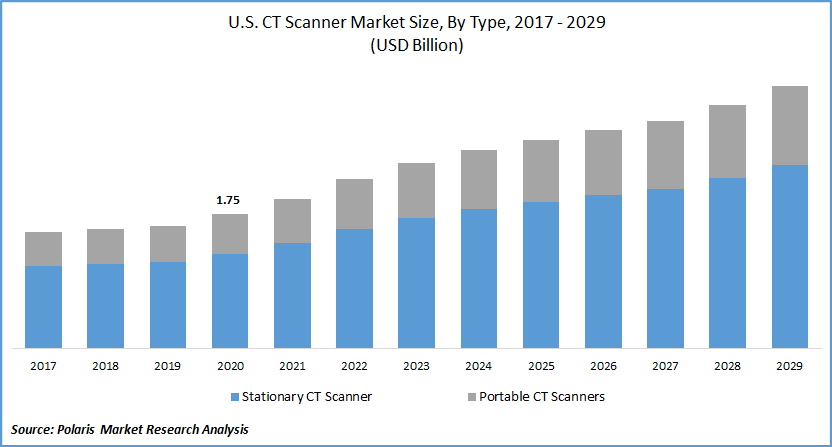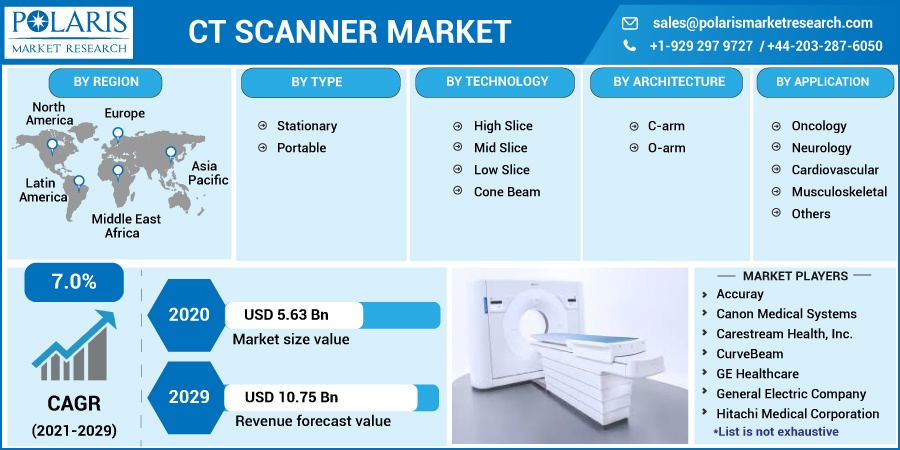
CT Scanner Market Share, Size, Trends, Industry Analysis Report, By Type (Stationary, Portable); By Technology (High Slice, Mid Slice, Low Slice, Cone Beam CT); By Architecture (C-arm, O-arm); By Application, By Region; Segment Forecast, 2021 - 2029
- Published Date:Nov-2021
- Pages: 101
- Format: PDF
- Report ID: PM1685
- Base Year: 2020
- Historical Data: 2017 - 2019
Report Summary
The global computed tomography (CT) scanner market was valued at USD 5.63 billion in 2020 and is expected to grow at a CAGR of 7.0% during the forecast period. The significant factors propelling the CT scanner market growth include advancements in scanner technology and device miniaturization, rising incidence of targeted diseases, need for early diagnosis for disease prevention, and growing preference towards minimally invasive procedures.
 Know more about this report: request for sample pages
Know more about this report: request for sample pages
The COVID-19 outbreak had both beneficial and bad consequences on the worldwide scanner business. There was no mobility for routine check-ups to clinics owing to the government shutdowns all around the world. Simultaneously, there was a greater propensity to use a scanners to diagnose COVID-19. Depending on false rates, scanner contaminants, and an absence of change in individual patients management, the (CDC) advised against frequent scans to identify COVID-19.
The increasing number of COVID-19 incidents has increased the demand for the product, which is projected to influence the market under consideration positively. In the UAE, for example, the Abu Dhabi Healthcare Services Business (SEHA) installed a 16-slice portable scanner in Summer 2020 to diagnose pneumonia in coronavirus patients, which shows that hospitals are employing scanners to identify COVID-19 which has increased the demand for the product.
 Know more about this report: request for sample pages
Know more about this report: request for sample pages
Market Dynamics
Growth Drivers
A significant increase in requirement for bedside imaging, remote healthcare, and increased usage of scanners to assess the effectiveness of post-interventional clinical treatments, surgical implants, and anatomical verification are important drivers boosting the CT scanner market expansion. The increasing prevalence of ailments such as orthopedic, cancer, cardiovascular, and dental issues would further boost the expansion of the scanner industry. Furthermore, constant growth in the number of medical implant surgeries due to changing lifestyles and an increasing geriatric population is expected to influence market development positively.
The increased prevalence of chronic illnesses such as cardiology, cancer, and neurology problems has resulted in a rise in early diagnosis. As per the National Center for Health Statistics, 1,806,590 new cancer cases were documented in the U.S. in 2020. Furthermore, the survey revealed that the prevalence rate had grown significantly over time. Moreover, to acquire a competitive edge over other companies, key market companies are releasing new cardiovascular-related goods. Canon Medical Systems Company, for example, released One-Beat Spectral Cardiac CT in November 2020, with quick kVp switching and machine learning spectra restoration, to obtain whole-heart spectral pictures in one heartbeat. The emergence of technologically sophisticated goods is expected to fuel demand, resulting in market expansion.
Report Segmentation
The market is primarily segmented on the basis of type, technology, architecture, application, and region.
|
By Type |
By Technology |
By Architecture |
By Application |
By Region |
|
|
|
|
|
Know more about this report: request for sample pages
Insight by Architecture
In 2020, the O-arm scanner market segment is expected to witness the fastest growth of 7.1% over the forecast period. Market demand for O-arm systems is being driven by an increase in scanner operations, increased acceptance of novel solutions, and new product introductions in this category. The C-arm sector is expected to grow rapidly due to the rising use of C-arms in experimental surgeries due to their open design and ease of patient accessibility.
Insight by Application
The oncology market segment is expected to account for 28.2% in 2021 in terms of revenue. The factors responsible for its growth are the rising incidence of different cancer types such as breast, lung, blood, colorectal cancers and rising demand for effective scanner solutions for disease prevention at an early stage. Moreover, Cancer Research UK predicted that, by 2040, globally, there would be around 27.5 million cancer cases if the same trend continued.
Geographic Overview
North America market is expected to account for 38.4% of the global revenue share in 2029 due to the region's huge patient demographic suffering from disease, patients' preference for advanced technologies, the presence of other chronic conditions, well-established producers developing advanced scanners, and adoption of advanced technologies to establish treatment for critical illnesses.
Asia Pacific region is projected to be the fastest-growing regional market over the study timeframe. Increasing privatization in the healthcare industry, rise in population coupled with an increase in lifestyle diseases, improving support from governments, rapidly growing number of hospitals, and growing economy are positive factors favoring its market growth.
China and India are the largest contributors to the scanner market due to the region's increasing investments in healthcare infrastructure. There is an increasing demand for cost-effective and efficient diagnosis in developing countries such as India and China due to limited budgets to invest in new medical imaging equipment such as computer tomography scanners.
Competitive Insight
Some of the players operating in the global CT scanner market include Accuray, Canon Medical Systems, Carestream Health, Inc., CurveBeam, GE Healthcare, General Electric Company, Hitachi Medical Corporation, iCRco, Inc., Koning Corporation, Koninklijke Philips, Medtronic Inc., NeuroLogica Corp., Neusoft, Planmed Oy, Samsung, Shenzhen Anke High-Tech, Siemens AG, United Imaging Technologies, and Xoran Technologies, LLC.
These players compete to increase their market share by offering a wide range of the systems at cheaper costs, comprehensive service offerings and warranty to the products purchased, strategic partnerships and agreements, and expanding presence to untapped markets.
For instance, GE Healthcare purchased Prismatic Sensors AB on November 20, 2020, an image producer located in Sweden. It is part of Sweden's next-generation photon-counting technologies, as well as it will assist GE Healthcare to boost medical studies on CT scanners. Moreover, in May 2021, Siemens Healthineers AG announced the release of the Somatom X.ceed Scanner. This novel technology was created for essential therapeutic areas where speed and accuracy are important.
CT Scanner Market Report Scope
|
Report Attributes |
Details |
|
Market size value in 2020 |
USD 5.63 billion |
|
Revenue forecast in 2029 |
USD 10.75 billion |
|
CAGR |
7.0% from 2021 - 2029 |
|
Base year |
2020 |
|
Historical data |
2017 - 2019 |
|
Forecast period |
2021 - 2029 |
|
Quantitative units |
Revenue in USD million/billion and CAGR from 2021 to 2029 |
|
Segments covered |
By Type, By Application, By Technology, By Architecture, By Region |
|
Regional scope |
North America, Europe, Asia Pacific, Latin America, Middle East & Africa |
|
Key Companies |
Accuray, Canon Medical Systems, Carestream Health, Inc., CurveBeam, GE Healthcare, General Electric Company, Hitachi Medical Corporation, iCRco, Inc., Koning Corporation, Koninklijke Philips, Medtronic Inc., NeuroLogica Corp., Neusoft, Planmed Oy, Samsung, Shenzhen Anke High-Tech, Siemens AG, United Imaging Technologies, and Xoran Technologies, LLC. |
License and Pricing
Purchase Report Sections
- Regional analysis
- Segmentation analysis
- Industry outlook
- Competitive landscape
Connect with experts
Suggested Report
- B2B2C Insurance Market Share, Size, Trends, Industry Analysis Report, 2022 - 2030
- Sinus Dilation Devices Market Share, Size, Trends, Industry Analysis Report, 2022 - 2030
- Claims Processing Software Market Share, Size, Trends, Industry Analysis Report, 2022 - 2030
- Connected Worker Market Research Report, Share and Forecast, 2022-2029
- Cool Roof Coatings Market Share, Size, Trends, Industry Analysis Report, 2022 - 2030

